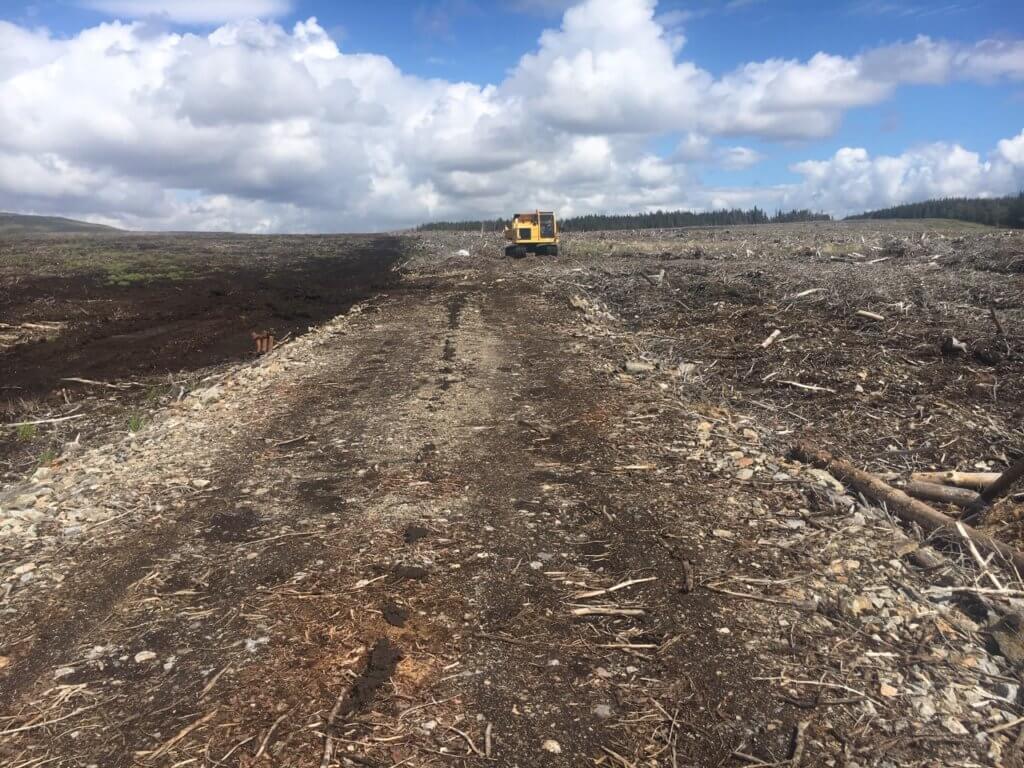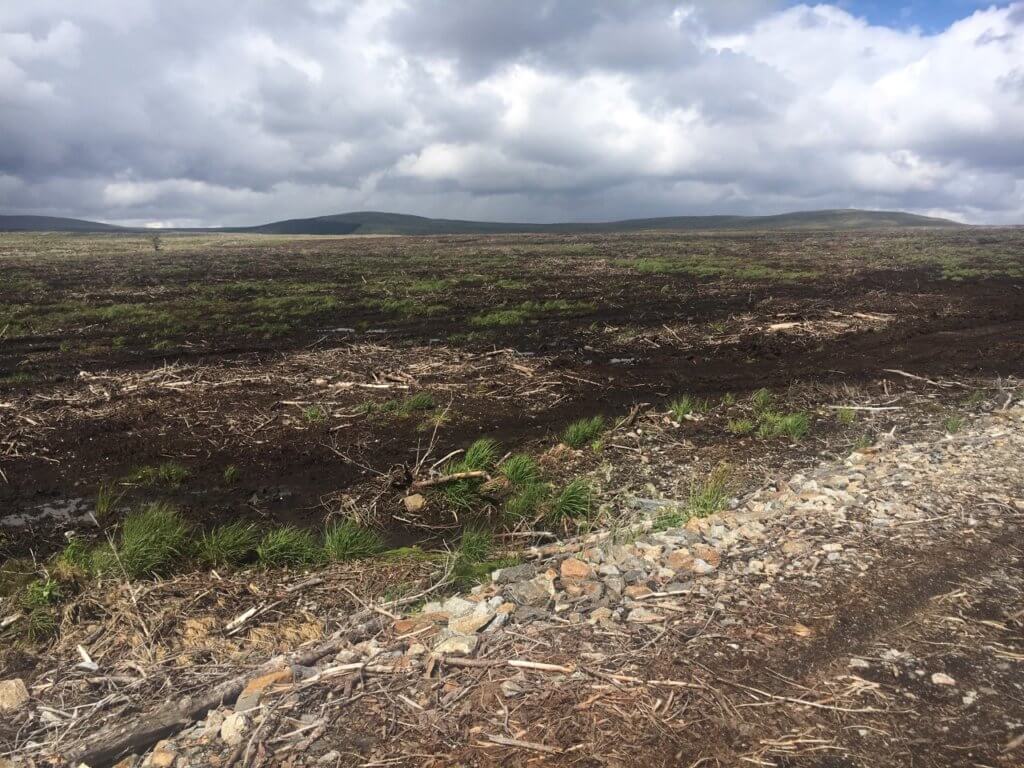
This area of bog and cotton grass used to be a conifer plantation. Who’d have known?
Thirty- three years ago when I first worked in the Flow Country of Sutherland and Caithness I often drove along the road north of Lairg which heads past Crask Inn to Altnaharra where you have the choice of continuing north to Tongue or east along Loch Naver. From Lairg to Crask one drove through a tunnel of dark thick conifers – planted years before and before the great afforestation of the wetter parts of the Flow Country.
I was back there last week and had the benefit of a tour of the Dalchork plantations with a local forester – who is now very much a local deforester and bog restorer. There have been great changes and they are mostly for the better.
The point of commercial forestry is usually to provide timber, and that means felling the trees at some stage! Once they are taken down then a wide variety of options open up: replant, replant with completely different trees, leave as open space, restore to the previous habitat and many others. Look at this image…

A few years ago, and for decades before, this view would have been a forest track with the tall trees on either side and ahead and behind us. But the trees are gone.
Look right and we see the mess of a clearfelled coupe…

Just because it’s a bit of a mess doesn’t mean there is no wildlife, in fact there were a lot of Redpolls in these felled areas – really, a lot – as well as the Meadow Pipits and Skylarks that were more expected.
But look left and we see this…

This area was a full-grown plantation a few years ago, and looked like the previous image last year, but now it is very obviously (very obviously if you are there anyway) a recovering peatland with wet bits and a growing cover of plants and mosses – and a few pairs of Lapwing already making use of it. I heard of some pretty interesting bird species already making use of these restored open spaces.
It’s quite a transformation and involves a few forest workers and big equipment – and quite a lot of skill.
And this transformation is happening on a large part of the northern Dalchork plantation. The state forestry service is here turning forest back into peatlands and that is something to be welcomed and celebrated. I welcome and celebrate it.
Now, I used the inelegant term ‘state forest service’ just now because I wonder whether you know what it is called. In England we now have Forestry England – that’s clear enough! And in Scotland they/we have Forestry and Land Scotland – that’s an interesting name!
I don’t fully know how the ‘and Land’ snuck in to that name but it is interesting. According to their web page ‘Many people think our work is timber production‘ but apparently ‘that is only part of the story‘. Forestry and Land Scotland does all sorts of things including nature conservation (although there is rather little evidence of that on the website yet) and what I saw in Dalchork was nature conservation on a large scale. Forestry and Land Scotland should certainly be shouting about it. Here is the plan for this area – it looks pretty good to me when you consider that it has been a relatively ugly, relatively unprofitable and relatively wildlife-free conifer planttion for decades.
I vaguely remember being told once that Dalchork was originally owned by the agriculture department but was handed over to the Forestry Commission because there wasn’t much that could be done with sheep in these parts. The tree people discovered that there wasn’t an awful lot that could be impressively done with trees here either and now the land, some of it at least, is going back to peatland. You could view this as a many-decade learning process where economic activities learned that life was a lot tougher than they thought in this part of the world – a tale of hubris perhaps. You could take that lesson from the Dalchork experience and there would be quite a lot of truth in it. It’s a lesson worth learning.
But I’d like to take a more positive lesson from it too. I’m glad that this land was and is in public ownership. If Dalchork had been split into many private ownerships then it would have been really difficult to arrive at the more positive future that I see planned for it by Forestry and Land Scotland. The same mistakes would have been made, I’m sure, but the emergence into a better future would have been one hell of a lot more difficult. I’m a fan of state ownership of land and we ought to have a lot more of it. It won’t prevent mistakes being made sometimes, but it is more likely to allow them to be corrected much more rapidly and efficiently. I’ve long thought that a Forest and Wildlife Service could be a good way forward and Scotland is edging that way it seems (Wales too, by the way).
As I drove back down the road to Lairg I remembered watching the 1986 World Cup game between England and Argentina – the Maradona Hand of God goal followed by his Goal of the Century – in a large static caravan with the rest of the RSPB survey team. Organisations, just like people, are able to do amazingly good things and amazingly bad things, sometimes in rapid succession. Foresters have to live with their mistakes for decades.
When I got to Lairg, and Little Loch Shin by the roadside and below the hydro dam, I thought I’d stop to see whether there were any Black-throated Divers around, as there often were. I prepared to give the loch a scan with binoculars when I noticed a spanking Black-throat just a few feet from the road – a gorgeous bird which stayed long enough to provide a visual feast before it flew off.
Search the internet for ‘Dalchork plantation peatland restoration’ as a good start if you want to find out more about this work.
[registration_form]
1986, I was up that way, sleeping in my yellow escort, you probably saw me about ?.
That was the last time I went any further than Forsinard,and swore never to do so again.
Do you know of any similar restoration projects,between Strath Halladale and Thurso, that might tempt me back ?, I cant see much from satellite imagery.
I love the Uists, and the Dotterel hills of Drumochter and upper Speyside, but the flows and lochs, either side of the railway past Altnabreac, were a different world.
I’m finding your “Flow” posts very informative. It’s perfectly coincidental for us as we were at Forsinard the same day as you; must have missed you by less than an hour. Your explanations in this post are equally interesting and you explanation of what’s really going on with the Dalchork Forest and other forests in the region are enlightening. Thanks for posting your observations. I hope there will be more “flow” instalments.
Redwing – thank you very much. I think I’m flowed out now. But Fighting for Birds has more information and Birds and Forestry does too.
Notice there’s a big ‘windfarm development area’ on that plan though. Do we agree with that?
What I remember about North Dalchork is the South Coastal Lodgepole Pines – miles of it and certainly not the sort of trees that bloocked the view – stunted, twisted bushes – Lodgepole the species that some of us were realising told us we had gone too far – as disastrous a forestry prospect as Sitka was good. I remember at the time (probably 1987) thinking we’d have done far better pulling back to a much smaller area that would grow some worthwhile trees, and leave the poorest ground (richest for wildlife) untouched – and now we have a plan which does exactly that !
My other reflection is that as planting stopped here and in Wales my assumption was that was the upland problem sorted. In the same period, as we discussed RSPB getting into Agriculture policy I assumed agriculture would go the same way as forestry – moderating its extremes and finding a better balance. Over 20 years later I came back to Welsh upland birds whilst preparing a talk for WOS and was shocked to discover that without any of the fanfare that accompanied (and still does) the Flow Country Welsh farming had quietly been getting on with finishing the job forestry began. And even worse when George Monbiot pointed out what was going on conservationists sprung to the defence of an upland Wildlife Trust reserve he had justly criticised. Welsh sheep seem well on the way to achieving something forestry never did – species extinction at a country scale. And in the meantime for one year forestry was left the only bastion against another country level extinction – Hen harriers by Grouse Shooting in England.
On the public ownership issue – be careful what you wish for, I work in peatland restoration in a national park which has an unusually large area owned by the NP (1000s ha). By far the most difficulty we have is restoring sites which are owned by the park, they are pathetically cowed by the views of the hyper conservative park authority board which still see peatland restoration as controvertial, and seem unable to grasp the urgency of looking after deep peat reserves at this critical point in the history of our planet. They instead put 19th century archaeology and worries about aesthetic landscape impacts ahead of the need to halt peatland damage. We’ve managed much more effective and impactful work on privately owned areas.
Ceeb – many thanks for that comment; your first here.